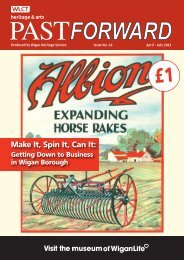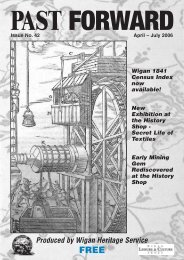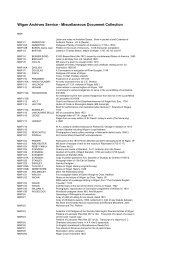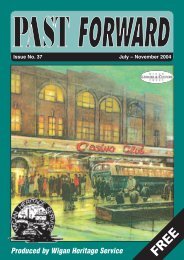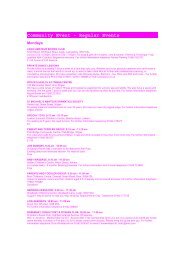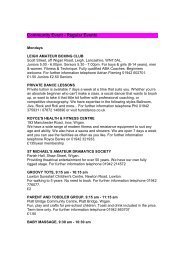A Royal Celebration - Wigan Leisure and Culture Trust
A Royal Celebration - Wigan Leisure and Culture Trust
A Royal Celebration - Wigan Leisure and Culture Trust
Create successful ePaper yourself
Turn your PDF publications into a flip-book with our unique Google optimized e-Paper software.
12<br />
Clogs<br />
By Tom Heaton<br />
A pair of ladies clogs<br />
If you were to ask me for one word that would<br />
remind me of my childhood in <strong>Wigan</strong> it would be<br />
‘clogs’. In Scholes, clogs were worn six days a<br />
week but rarely on Sundays – except in winter<br />
when it was freezing <strong>and</strong> “t’Clarry were<br />
‘howdin”. I feel sorry for children today who will<br />
never know the delight of sliding on iron shod<br />
clogs. The lower part of Great Acre Park facing St<br />
George’s School, known to most as the bowling<br />
green, was set at a perfect angle for ‘slorrin’. At<br />
the first sign of a hoar frost a line of lads wearing<br />
clogs would choose a patch of grass <strong>and</strong>, facing<br />
uphill, holding on to each others waist, would<br />
slide their feet backwards <strong>and</strong> forwards. In a<br />
relatively short time, the surface turned to ice<br />
forming a perfect ‘piste’ or ‘slorr’ as it was called<br />
in <strong>Wigan</strong>. Of course girls couldn’t slide very well<br />
as their clogs had ‘rubber irons’. I never mastered<br />
the skill but some lads could skate on the frozen<br />
<strong>Wigan</strong> mill girls, circa 1900. Notice their clogs.<br />
Clarrington Brook on the inside irons of their<br />
clogs as fast, if not faster than many a real ice<br />
skater on skates.<br />
Clog irons of course wear out which meant a trip<br />
to the nearest clogger’s. My favourite of several in<br />
Scholes was the wood yard off Greenough Street.<br />
In front of the entrance to this clog factory lay a<br />
gigantic tree trunk. I used to think that this<br />
provided the material for all the clog soles they<br />
made but I suspect now that I was wrong as I<br />
have discovered that blocks of wood roughly the<br />
size of clog soles were made in the woods, often<br />
in Wales by people, many of them by gypsies, who<br />
lived in tents on site. George Borrow mentions this<br />
in his famous book ‘Wild Wales’, written in the<br />
early part of the nineteenth century. He said that<br />
they were made of alder <strong>and</strong> exported to the<br />
Lancashire clog makers. Alder was a particularly<br />
waterproof wood, useful for working in wet<br />
conditions often encountered in some of the<br />
mines around <strong>Wigan</strong>. “O’er t’clog tops” was a<br />
common expression. Sycamore, a soft, easily<br />
worked wood is mostly used today I have learned.<br />
I still have a vivid picture in my mind of a line of<br />
little lads at the wood yard sitting on a long form<br />
in their stocking feet, swinging their legs as they<br />
waited for their newly shod clogs to be h<strong>and</strong>ed<br />
over. Time didn’t matter as there was an array of<br />
fascinating machinery to entertain them as the<br />
experienced workers stitched the leather uppers<br />
together before nailing them onto the skilfully<br />
shaped, wooden soles.<br />
There were three main types of clogs; lace-ups<br />
with leather laces favoured by men <strong>and</strong> big lads<br />
<strong>and</strong> low-down clasped ones worn by us younger<br />
lads <strong>and</strong> strangely also by old men. Girls of course<br />
wore a more elegant version with a dainty strap<br />
across the top. My memory tells me that there



